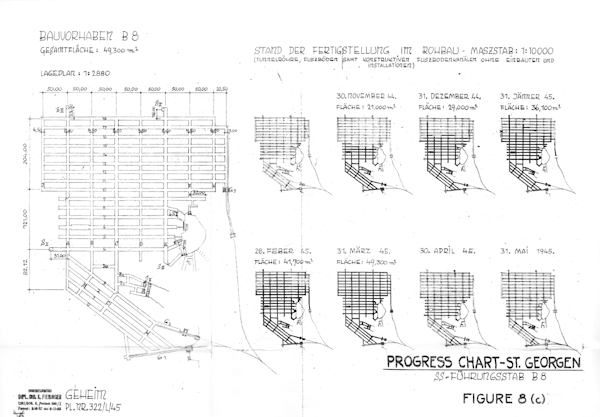Relocating arms production underground
 Stand der Fertigstellung von B 8 / „Bergkristall“. Der britische und amerikanische Geheimdienst bewertete „Bergkristall“ in einem Bericht über die unterirdischen Fertigungsstätten des Deutschen Reiches als “eine der vollständigsten und modernsten“. Dem Bericht ist außerdem eine im Ingenieurbüro Karl Fiebinger erstellte Übersicht über den Stand der Fertigstellung des Bauvorhabens „Bergkristall“ beigefügt. Dieser zeigt den extrem raschen Baufortschritt. Bis 30. November 1944 wurden 21.000 m² Fertigungsfläche fertiggestellt, bis 31. März 1945 49.300 m². (German Underground Installations, Part One: Unique Design and Construction Methods. CIOS Section Intelligence Division Office, Washington D.C.: Septem)Plans to relocate arms production to a bomb-proof location were devised as early as 1943. The Allied air raids in summer 1943 forced the companies and the NS authorities to devise immediate countermeasures. In the context of relocation to underground facilities, the importance of the SS grew with that of KZ prisoner labour. From 1944, finally, the construction of subterranean facilities determined the work assignments using the labour of KZ prisoners.
Stand der Fertigstellung von B 8 / „Bergkristall“. Der britische und amerikanische Geheimdienst bewertete „Bergkristall“ in einem Bericht über die unterirdischen Fertigungsstätten des Deutschen Reiches als “eine der vollständigsten und modernsten“. Dem Bericht ist außerdem eine im Ingenieurbüro Karl Fiebinger erstellte Übersicht über den Stand der Fertigstellung des Bauvorhabens „Bergkristall“ beigefügt. Dieser zeigt den extrem raschen Baufortschritt. Bis 30. November 1944 wurden 21.000 m² Fertigungsfläche fertiggestellt, bis 31. März 1945 49.300 m². (German Underground Installations, Part One: Unique Design and Construction Methods. CIOS Section Intelligence Division Office, Washington D.C.: Septem)Plans to relocate arms production to a bomb-proof location were devised as early as 1943. The Allied air raids in summer 1943 forced the companies and the NS authorities to devise immediate countermeasures. In the context of relocation to underground facilities, the importance of the SS grew with that of KZ prisoner labour. From 1944, finally, the construction of subterranean facilities determined the work assignments using the labour of KZ prisoners.
Two tunnels systems were planned for the area near the KZ Gusen. In late 1943, construction of the "Kellerbau" system commenced near the Kastenhof quarry, but soon ran afoul of geological difficulties. The 8,000 m² of tunnel which were completed were used as production facilities for Steyr-Daimler-Puch AG. and Messerschmitt GmbH. Regensburg. Construction work caused numerous accidents and led to the death of a significant number of prisoners.
In 1944, at St. Georgen, the SS began one of the major tunnel projects of the German war-time industry codenamed B 8 / "Bergkristall" which was meant to house subterranean facilities for the production of Messerschmitt fighter planes.
To house the thousands of prisoners necessary for the project, the barracks complex of Gusen II was built.
From March 1944, tunnel construction was supervised by the SS-Sonderstab Kammler, which had already been in charge of more than 20 such major projects in other parts of the Reich. Hans Kammler, head of Department C ‘Construction’ of the SS Economic Administration Headquarters, had already demonstrated his "reliability" in the autumn of 1943, during the relocation of rocket production to underground facilities, when he had pushed the construction projects forward without the slightest regard for the health or survival of KZ inmates. The same principles came to determine the construction of the Bergkristall tunnels which caused massive deaths at Gusen II. As with most other subterranean projects on Austrian territory, the tunnel project had been planned by the engineering office of Karl Fiebinger in Vienna.
In August 1944, 3,684 concentration camp prisoners had already been assigned to work in the construction project and the number of prisoners at times exceeded 6,000. Following the completion of the first tunnels in autumn 1944, Messerschmitt GmbH. Regensburg took up production of its Me 262 jet fighter.